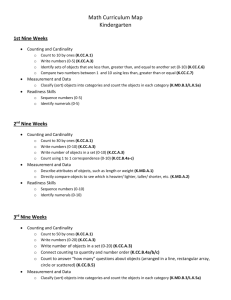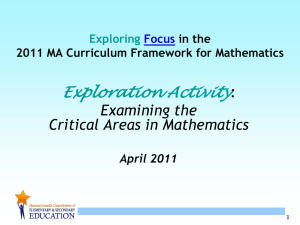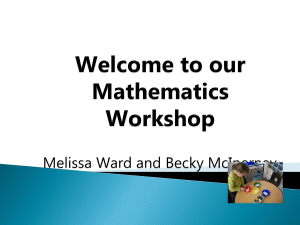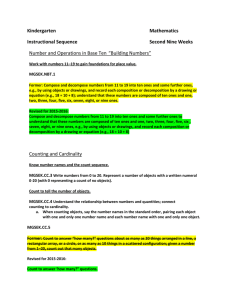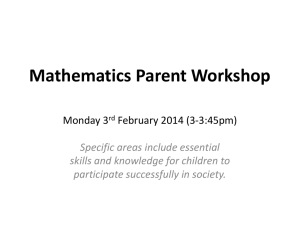Math K - Mentor School District
advertisement
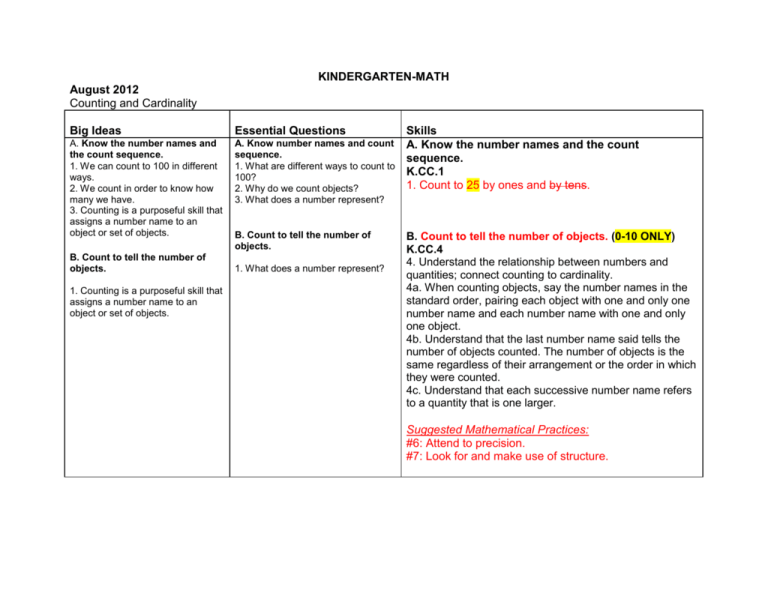
KINDERGARTEN-MATH August 2012 Counting and Cardinality Big Ideas Essential Questions A. Know the number names and the count sequence. 1. We can count to 100 in different ways. 2. We count in order to know how many we have. 3. Counting is a purposeful skill that assigns a number name to an object or set of objects. A. Know number names and count sequence. 1. What are different ways to count to 100? 2. Why do we count objects? 3. What does a number represent? B. Count to tell the number of objects. 1. Counting is a purposeful skill that assigns a number name to an object or set of objects. B. Count to tell the number of objects. 1. What does a number represent? Skills A. Know the number names and the count sequence. K.CC.1 1. Count to 25 by ones and by tens. B. Count to tell the number of objects. (0-10 ONLY) K.CC.4 4. Understand the relationship between numbers and quantities; connect counting to cardinality. 4a. When counting objects, say the number names in the standard order, pairing each object with one and only one number name and each number name with one and only one object. 4b. Understand that the last number name said tells the number of objects counted. The number of objects is the same regardless of their arrangement or the order in which they were counted. 4c. Understand that each successive number name refers to a quantity that is one larger. Suggested Mathematical Practices: #6: Attend to precision. #7: Look for and make use of structure. September 2012 Counting and Cardinality Big Ideas Essential Questions A. Know number names and count the sequence. 1. Counting is a purposeful skill that assigns a number name to an object or group of objects. A. Know number names and count the sequence. B. Count to tell the number of objects. 1. Counting is a purposeful skill that assigns a number name to an object or group of objects. C. Describe and compare measurable attributes. 1. Objects can be described and compare to each other using different attributes.2. Measurement processes and attributes are used tin everyday life to describe and quantify the world. 1. What does a number represent? 2. How many are there? Skills A. Know the number names (0-10) and the count sequence (0-25). K.CC.1 1. Count to 25 by ones and tens. B. Count to tell the number of objects. (0-10 ONLY) K.CC.4 B. Count to tell the number 4. Understand the relationship between numbers and of objects. quantities; connect counting cardinality. 1. How do you know how many 4a. When counting objects, say the number names in objects are in a group? the standard order, pairing each object with one and only one number name and each number name with one and only one object. C. Describe and compare 4b. Understand that the last number name said tells measurable attributes. the number of objects counted. The number of objects 1. How do we compare is the same regardless of their arrangement or the different groups of things? 2. Why does "what" we order in which they were counted. measure influence "how" we 4c. Understand that each successive number name measure? refers to a quantity that is one larger. C. Describe and compare measurable attributes. K.MD.1 1. Describe measurable attributes of objects, such as length or weight. Describe several measurable attributes of a single object. Suggested Mathematical Practices: #6: Attend to precision. #7: Look for and make use of structure. October 2012 Counting and Cardinality; Measurement and Data Big Ideas Essential Questions A. Classify objects and count A. Classify objects and the number of objects in each count the number of category. objects in each category. 1. We sort by using different 1. Why does "what" we attributes. (color, shape and measure and sort influence size). "how" we measure and sort? B. Know number names and the count sequence. 1. Counting forward doesn't always have to start with number 1. 2. Counting is a purposeful skill that assigns a number name to an object or set of objects. C. Count to tell the number of objects. 1. When counting objects, numbers increase by one. 2. Arrangement of objects does not affect the amount or total. 3. The last number counted represents the total. D. Compare numbers. 1. Counting is a purposeful skill that assigns a number name to B. Know number names and the count sequence. 1. What does a number represent? Skills A. Classify objects and count the number of objects in each category. K.MD.3 1. Classify objects into given categories; count the numbers of objects in each category and sort the categories by count. B. Know number names (Master) and the count sequence 0-25 (Master). K.CC.2 ONLY 0-10 2. Count forward beginning from a given number within the known sequence (instead of having to begin at 1.) 2. How many are there? C. Count to tell the number of objects. 1. What does a number represent? 2. How many are there? C. Count to tell the number of objects. K.CC.4 ONLY 0-10 4. Understand the relationship between numbers and quantities; connect counting to cardinality. 4a. When counting objects, say the number names in the standard order, pairing each object with one and only one number name and each number name with one and only one object. 4b. Understand that the last number name said tells the number of objects counted. The number of objects is the same regardless of their arrangement or the order in which they were counted. 4c.Understand that each successive number name refers an object or set of objects. D. Compare numbers. to a quantity that is one larger. E. Know number names and the count sequence. 1. What does a number represent? 1. Numbers help represent how many objects you have. 2. How many are there? D. Compare numbers. K.CC.6 ONLY 0-10 6. Identify whether the number of objects in one group is greater than, less than, or equal to the number of objects in another group, e.g., by using matching and counting strategies. Suggested Mathematical Practices: #2: Reason abstractly and quantitatively. E. Know number names and the count sequence. 1. What does a number represent? E. Know number names and the count sequence K.CC.3 Only 0-10 3. Write numbers from 0 to 20. Represent a number of objects with a written numeral 0-20 (with 0 representing a count of no objects). Suggested Mathematical Practices: #4:Model with mathematics. #6: Attend to precision. #7: Look for and make use of structure. November 2012 Counting and Cardinality, Measurement and Data Big Ideas A. Know number names and count the sequence. 1. We can count by 1's and 10's. 2. We count in order so we know how many we have. 3. Numbers show how many things we have. Essential Questions A. Know number names and count the sequence. 1. How many are there? 2. What does a number represent? B. Compare Numbers. 1. Numbers can be compared in many ways having more than, less than or equal amounts. B. Compare Numbers. 1. What are different ways we can B. Compare Numbers compare numbers and objects? K.CC.7 7. Compare two numbers between 1-10 as C. Classify objects and count written numerals. (more or less) the number in each category. 1. How does "what" we measure and sort influence "how" we C. Classify objects and count the number in measure and sort? each category. (0-20 only) K.MD.3 3. Classify objects into given categories; count the numbers of objects in each category and sort the categories by count. Mathematical Practices: #6: Attend to precision. #7: Look for and make use of structure. #2: Reason abstractly and quantitatively. C. Classify objects and count the number in each category. 1. We measure and sort in everyday life to describe and quantify the world. Skills A. Know number names (0-20) and count the sequence. (0-50 only) Introduce K.CC.2 1. Count forward beginning from a given number within the known sequence instead of having to begin at 1. 2. Count to 50 by ones and tens to 100. December 2012 Counting and Cardinality; Measurement and Data Big Ideas A. Count and tell the number of objects. 1. Counting is a strategy for finding the answer to how many. Essential Questions A. Count and tell the number of objects 1. How do you know how many objects are in a group? Skills A. Count and tell the number of objects. (0-20) K.CC.5 1. Count 0-20 objects. 2. Given a number, count that many objects 0-20. 3. Number Identification 0-20. B. Compare Numbers B. Compare Numbers 1. What are different ways that we can compare numbers? B. Compare Numbers K.CC.7 1. Compare two written numbers between 0-10 as more or less. (MASTERY) K.CC.6 1. Comparing groups of objects 0-20 as more than, less than, or equal to. (Introduce “equal”) 1. We can compare numbers in different ways. C. Classify objects and count the number in each category 1. We sort by using different attributes. C.. Classify objects and count the number in each category. 1. What are different ways we can sort objects? C. Classify objects and count the number in each category. (0-20) K.MD.3 1. Sort and classify objects into given categories and count the numbers in each group. 2. Sort the categories by count. Mathematical Practices: #6: Attend to precision. #2: Reason abstractly and quantitatively. January 2013 Counting and Cardinality; Measurement and Data; Geometry Big Ideas A. Know number names and count the sequence. 1. Counting is a purposeful skill that assigns a number name to an object or set of objects without regard to where we begin counting. B. Describe and compare measurable attributes. 1. Objects can be described and compare to each other using different attributes.2. Measurement processes and attributes are used tin everyday life to describe and quantify the world. C. Identify and Describe shapes. 1. Shapes are everywhere. 2. Positional words can be used to describe where objects are compared to other objects around them. Essential Questions Skills A. Know number names A. Know number names and count the sequence. and count the K.CC.1 sequence. 1. Count to 75 by ones. (Introduction) 1. What are different Count to 100 by tens. (MASTERY) ways we can count to K.CC.2 100? 0-20 ONLY 2. Count forward beginning from a given number within the known sequence (instead of having to begin at 1). K.CC.3 3. Write the numbers 0-20. Represent a number of objects with a written numeral 0-20 (with 0 representing a count of no objects). B. Describe and compare measurable attributes. 1. How do we compare different groups of things? 2. Why does "what" we measure influence "how" we measure? C. Identify and describe shapes. 1. Where can you find shapes? B. Describe and compare measurable attributes. K.MD.1 1. Describe measurable attributes of objects, such as length or weight. Describe several measurable attributes of a single object. K.MD.2 2. Directly compare two objects with a measurable attribute in common to see which object has "more of/less of" and describe the difference. For example, directly compare the heights of two children and describe one child as taller/shorter. C. Identify and describe shapes (squares, circles, triangles, rectangles, and hexagons) K.G.1 3. Geometric attributes, such as shapes, lines, angles, figures and planes, provide descriptive information about an object's properties and position in space and support visualization and problem solving. D. Analyze, compare, create and compose shapes. 1. Geometric attributes, such as shapes, lines, angles, figures and planes, provide descriptive information about an object's properties and position in space and support visualization and problem solving. 2. How do we describe where objects are located? 3. How does geometry describe shapes? 1. Describe objects in the environment using names of shapes and relative positions of these objects using terms such as above, below, beside, in front of, behind, and next to. K.G.2 2. Correctly name shapes regardless of their orientations or overall size. D. Analyze, compare, create and compose shapes. 1. How does geometry better describe objects? D. Analyze, compare, create and compose shapes. K.G.4 4. Analyze and compare two- and three-dimensional shapes (cubes, cones, sphere, cyclinder), in different sizes and orientations, using informal language to describe their similarities, differences, parts (e.g., number of sides and vertices/“corners”) and other attributes (e.g., having sides of equal length). K.G.5 5. Model shapes in the world by building shapes from components (e.g., sticks and clay balls) and drawing shapes. K.G.6 6. Compose simple shapes to form larger shapes. For example, “Can you join these two triangles with full sides touching to make a rectangle Suggested Mathematical Practices: #7: Look for and make use of structure. #4: Model with mathematics. #6: Attend to precision. #8: Look for and express regularity in repeated reasoning. #3: Construct viable arguments and critique the reasoning of others. February 2013 Geometry; Measurement and Data; Numbers and Operations in Base Ten Big Ideas Essential Questions A. Analyze, compare, create and compose shapes. 1. Shapes can be described in many ways. A. Analyze, compare, create and compose shapes. 1. How can we compare different shapes? 2. Geometric attributes, such as shapes, lines, angles, figures and planes, provide descriptive information about an object's properties and position in space and support visualization and problem solving. 2. How does geometry better describe our world? B. Identify and describe shapes (squares, circles, triangles, rectangles, hexagons, cubes, cones, cylinders and spheres. 1. Geometric attributes, such as shapes, lines, angles, figures and planes, provide descriptive information about an object's properties and position in space and support visualization and problem solving. 2. Shapes are everywhere. 3. Positional words can be used to describe where objects are compared to other objects around them. B. Identify and describe shapes (squares, circles, triangles, rectangles, hexagons, cubes, cones, cylinders and spheres. 1. How can you describe shapes? 2. Where can you find shapes? Skills A. Analyze, compare, create, and compose shapes. K.G.4 4. Analyze and compare two- and three-dimensional shapes, in different sizes and orientations, using informal language to describe their similarities, differences, parts (e.g., number of sides and vertices/“corners”) and other attributes (e.g., having sides of equal length). K.G.5 5. Model shapes in the world by building shapes from components (e.g., sticks and clay balls) and drawing shapes. B. Identify and describe shapes (squares, circles, triangles, rectangles, hexagons, cubes, cones, cylinders, and spheres) K.G.1 1 Describe objects in the environment using names of shapes, and describe the relative positions of these objects using terms such as above, below, beside, in front of, behind, and next to. K.G.3 3 Identify shapes as two-dimensional (lying in a plane, “flat”) or three-dimensional (“solid”). C. Describe and compare measurable attributes 1. Measurement processes are used in everyday life to describe and quantify the world. 2. Different data displays describe and represent data in alternative ways. D. Work with numbers 11-19 to gain foundations for place value. 1. Understanding place value can lead to number sense and efficient strategies for computing with numbers. C. Describe and compare measurable attributes. 1. Why does "what " we measure influence "how" we measure? 2. Why do we display or write data in different ways? D. Work with numbers 1119 to gain foundations for place value. 1. How does a digit's position affect its value? C. Describe and compare measurable attributes K.MD.1 1. Describe measureable attributes of objects such as length and weight. Describe several measureable attributes of a single object. D. Work with numbers 11–19 to gain foundations for place value K.NBT.1 1. Compose and decompose numbers from 11 to 19 into ten ones and some further ones, e.g., by using objects or drawings, and record each composition or decomposition by a drawing or equation (e.g., 18 = 10 + 8); understand that these numbers are composed of ten ones and one, two, three, four, five, six, seven, eight, or nine ones. Suggested Mathematical Practices: #4: Model with mathematics. #3: Construct viable arguments and critique the reasoning of others. #6: Attend to precision. March 2013 Operations and Algebraic Thinking Big Ideas Essential Questions A. Understand addition is putting together and adding to, and understand subtraction is taking apart and taking from. A. Understand addition is putting together and adding to, and understand subtraction is taking apart and taking from. 1. Mathematical operations are used in solving problems in which a new value is produced from one or more values. 2. Algebraic thinking involves choosing, combining and applying effective strategies for answering quantitative questions. 1. In what ways can operations affect numbers? 2. How can different strategies be helpful when solving a problem? Skills A. Understand addition is putting together or adding to, and understand subtraction is taking apart or taking from. K.OA.1 1. Represent addition and subtraction with objects, fingers, mental images, drawings, sounds, acting out, verbal explanations, expressions or equations. Drawings need not show details, but should show the mathematics in the problem. K.OA.2 2. Solve addition and subtraction word problems, and add and subtract within 10, e.g., by using objects or drawings to represent the problem. Mathematical Practices: #4: Model with mathematics. #5: Use appropriate tools strategically. April 2013 Operations and Algebraic Thinking Big Ideas Essential Questions A. Know number names and count the sequence. 1. Counting is a purposeful skill that assigns a number name to an object or set of objects without regard to where we begin counting A. Know number names and count the sequence. 1. What are different ways we can count to 100? B. Understand addition is putting together or adding to, and understand subtraction is taking apart or taking from. 1. Mathematical operations are used in solving problems in which a new value is produced from one or more values. 2. Algebraic thinking involves choosing, combining and applying effective strategies for answering quantitative questions. B. Understand addition is putting together or adding to, and understand subtraction is taking apart or taking from. 1. In what ways can operations affect numbers? 2. How can different strategies be helpful when solving a problem? Skills A. Know number names and count the sequence. K.CC.1 1. Count to 100 by ones. (Introduction) Count to 100 by tens. (MASTERY) B. Understand addition is putting together or adding to, and understand subtraction is taking apart or taking from. K.OA.3 3. Decompose numbers less than or equal to 10 into pairs in more than one way, e.g., by using objects or drawings, and record each decomposition by a drawing or equation (e.g., 5 = 2 + 3 and 5 = 4 + 1) K.OA.4 4. For any number from 1 to 9, find the number that makes 10 when added to the given number, e.g., by using objects or drawings, and record the answer with a drawing or equation. Mathematical Practices: #7: Look for and make use of structure. May 2013 Operations and Algebraic Thinking Big Ideas Essential Questions A. Understand addition is putting together or adding to, and understand subtraction is taking apart or taking from. A. Understand addition is putting together or adding to, and understand subtraction is taking apart or taking from. 1. Mathematical operations are used in solving problems in which a new value is produced from one or more values. 2. Algebraic thinking involves choosing, combining, and applying effective strategies for answering quantitative questions. 1. What are the different ways operations affect numbers? B. Work with numbers 11-19 to gain foundations for place value. 1. Understanding place value can lead to number sense and efficient strategies for computing with numbers. Skills A. Understand addition is putting together or adding to, and understand subtraction is taking apart or taking from. K.OA.5 5. Fluently add and subtract within 5 2. How can different strategies be helpful when solving a problem? B. Work with numbers 11-19 to gain foundations for place value. 1. How does a digit's position affect its value? B. Work with numbers 11-19 to gain foundations for place value. (HOPKINS) K.NBT.1 MASTERY 1. Compose and decompose numbers from 11 to 19 into ten ones and some further ones, e.g., by using objects or drawings, and record each composition or decomposition by a drawing or equation (e.g., 18 = 10 + 8); understand that these numbers are composed of ten ones and one, two, three, four, five, six, seven, eight, or nine ones. Suggested Mathematical Practices: #4. Model with mathematics. #8: Look for and express regularity in repeated reasoning.
